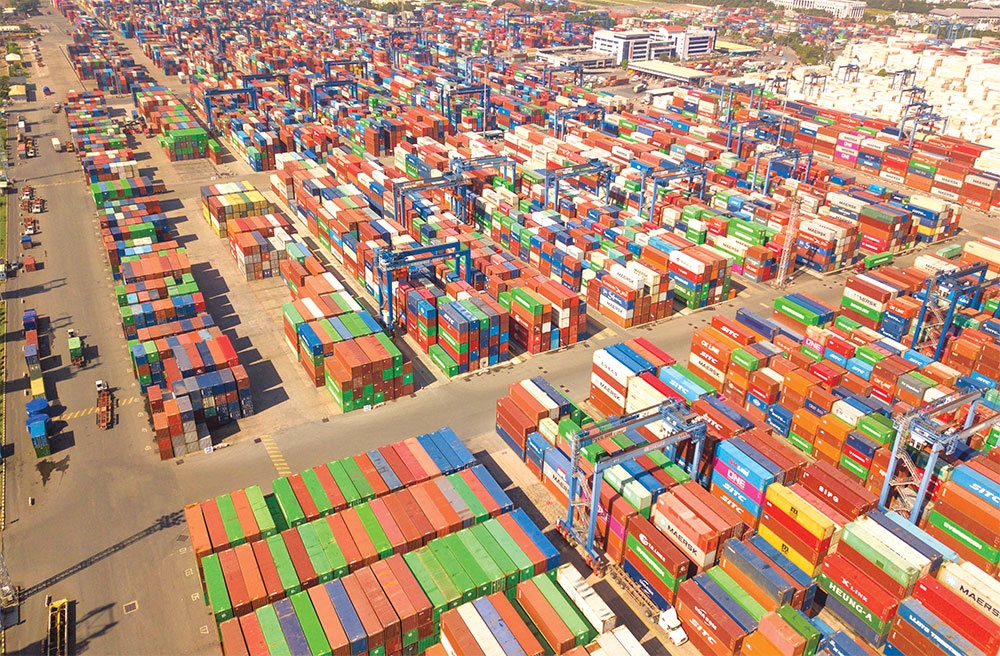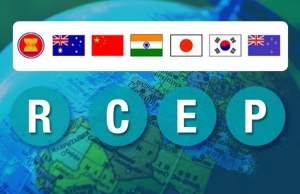RCEP boosting like-minded vision among bloc members
 |
| The RCEP accounts for over a quarter of global exports, photo Le Toan |
On January 2, the Regional Comprehensive Economic Partnership (RCEP) took effect for Indonesia. The preferential tariffs under the deal can now be used by the private sector who are exporting to and/or importing from Indonesia, according to the ASEAN Secretariat.
In a release issued by the Indonesian Ministry of Trade, Minister Zulkifli Hasan said that the RCEP is expected to increase competitiveness and strengthen global production network, promote regional supply chain through better market access for exports of goods and services, reduce or eliminate trade barriers, and enhance transfer of technology.
“The entry into force of the RCEP is timely to mark the beginning of Indonesia’s ASEAN Chairmanship in 2023. Indonesia has been the driving force in the deal since the conceptualisation phase, and we hope more milestones, such as the establishment of the RCEP Support Unit, can be achieved during Indonesia’s ASEAN Chairmanship this year,” said Satvinder Singh, Deputy Secretary-General for the ASEAN Economic Community.
The entry into force for Indonesia brings the full implementation of the deal one step closer to making ASEAN the hub of production networks within the region, said the ASEAN Secretariat.
Inked in November 2020 by the 10 ASEAN member states and Australia, China, Japan, South Korea, and New Zealand, the RCEP entered into force for all members a year ago, except for Indonesia, the Philippines, and Myanmar.
At the ASEAN Summit and Related Summits held in November in Cambodia, regional member states agreed that they want to see a favourable investment and trade climate in the region, with the RCEP to be fully adopted by the remaining nations.
“We welcomed the entry into force and look forward to its full and effective implementation to contribute to economic recovery, inclusive development as well as our support for an open, inclusive, rules-based trade and investment arrangement,” the statement said. We acknowledge the significance of the RCEP in contributing to our region’s economic recovery as well as its important role in the region’s bouncing back faster, better and stronger amidst regional and global challenges.
It is expected that the Philippines will adopt the RCEP early this year, while the status of Myanmar remains unclear.
Top benefits
The RCEP covers a market of 2.3 billion people and $26.2 trillion in global output. This accounts for about 30 per cent of the population worldwide and over a quarter of world exports.
According to consultancy firm Dezan Shira & Associates, the agreement will reduce tariffs and set trade rules, and help link supply chains, particularly as governments grapple with pandemic effects. The free trade agreement is expected to cover all aspects of business including trade, services, e-commerce, telecommunications, and copyright, though negotiations over some aspects still need to be finalised. Tariffs are expected to be reduced within 20 years.
The ASEAN Secretariat stated in its 2023 ASEAN Investment Report released last month that with its one-year entry into force, the RCEP has contributed to the region’s performance remarkably.
“The climate for manufacturing has also been significantly improved. Member countries committed to providing duty-free access to goods that represent 92 per cent of tariff lines. They also pledged to harmonise many rules and regulations that affect e-commerce and trade,” the report stated. “This will create greater access to Asia’s largest and most developed markets, lower the costs of importing manufacturing inputs, and make it easier for companies to build supply chains that leverage different advantages and skills across the region.”
According to the report, manufacturers are already taking advantage of this economic integration. Japanese multinational Yokogawa Electrical Corporation illustrates how companies can benefit from distributing segments of the value chain across more than one ASEAN country, benefiting from low costs in one and advanced manufacturing in another.
The company makes precision instruments for industries ranging from chemicals to steel to aerospace. It manufactures components and subassemblies on the Indonesian island of Batam and then ships them to Singapore, where Yokogawa has an innovation centre and its regional logistics hub, for final assembly and testing.
Semiconductor manufacturer Infineon uses a similar strategy. It assembles and packages more than 400 million semiconductor devices each year in Batam and ships them for testing to Singapore, where Infineon also has research and development and Industry 4.0 centres.
Under the RCEP’s commitments, member states are to remove around 88-98 per cent of tariff lines for Vietnam, and ASEAN countries pledged to do that with 86-100 per cent of tariff lines. The longest roadmap for tariff elimination is 15-20 years from when the agreement became valid.
According to Dezan Shira & Associates, as the RCEP is focused on trade facilitation, the blue-collar sector is expected to benefit the most. Additionally, consumer sectors like tourism, education, entertainment, healthcare, and retail are also expected to benefit as the middle class expands. Further, Vietnam’s export-oriented industries such as IT, agriculture, automobiles, footwear, and telecommunications are also expected to see gains.
Eyes on Vietnam
Jaya Ratnam, Singaporean Ambassador to Vietnam, told VIR that the RCEP is contributing to improve the investment and trade ties between his nation and Vietnam, and Singaporean companies are seeing many opportunities in Vietnam.
“At the regional level, Singapore and Vietnam are also like-minded partners in trade deals like the RCEP,” Ambassador Ratnam said. “Singapore and Vietnam share strong trade ties, which have remained robust. Bilateral trade has grown steadily over the past decade, reaching SGD26.9 billion ($20 billion) in 2021, an 18.7 per cent increase on-year. Singapore was also Vietnam’s second largest cumulative foreign investor, with around $70 billion put into around 3,600 projects as of June 2022.”
Indonesian Ambassador to Vietnam Denny Abdi also highlighted that the RCEP is expected to facilitate Indonesian companies to perform in Vietnam.
“Vietnam continues to be an attractive destination for foreign enterprises. Vietnam’s position is considered strategic for the enhancement of mutually beneficial economic cooperation,” he said. “Vietnam can serve as an entry point for Indonesian investors to the 98 million people of Vietnam’s domestic market as well as entrance to surrounding ASEAN countries such as Laos and Cambodia by utilising tariff preferences in ASEAN; and to Vietnam’s third-largest trading partner countries such as the US, EU, the Eurasian Economic Union, and China as Vietnam’s trade relations with these countries are significant and increasing.”
The Vietnamese Ministry of Planning and Investment (MPI) reported that as of December 20, 2022, Vietnam attracted over $98 billion in registered capital from ASEAN member states, including Singapore ($70.85 billion), Thailand ($13 billion), Malaysia ($13 billion), Indonesia ($638.9 million), and the Philippines ($606 million), Laos ($71 million), and Cambodia ($69.4 billion).
Meanwhile, registered capital from Australia, China, Japan, South Korea, and New Zealand reached $1.98 billion, $23.35 billion, $68.9 billion, $81 billion, and $210.6 million, respectively.
The ASEAN Secretariat has highly appreciated such facilitation in Vietnam, which it said boasts great potential to attract more foreign investment both inside and outside ASEAN.
“The investment environment in Vietnam has improved over the years, as corroborated by survey findings from foreign chambers of commerce based in the country,” the secretariat said. “The government has introduced measures to simplify requirements, reduce steps and streamline processes to facilitate such activities.”
Specifically, the Vietnamese government has continued to reform and take steps to further improve the country’s investment environment, including implementing resolutions and regulatory directives on strengthening information provision, simplifying processes, and reducing administrative requirements.
For example, the existing Law on Investment covers Vietnam’s efforts to attract foreign funding, including in certain activities such as university education, pollution mitigation and medical research. It also addresses granting of incentives to promoted activities. What is more, the Law on Public-Private Partnership Investment prioritises key industries such as transportation, electricity grid and power plants, irrigation, water supply and treatment, healthcare, and IT infrastructure for public-private partnerships.
“The Vietnamese government has put in place more facilitation measures in recent years to increase efficiency and improve the country’s funding environment. The MPI made greater use of digital technologies and online facilities during the pandemic to support investors,” the Secretariat said.
 | RCEP among most-promising trade agreements for Vietnam Vietnam is expected to reap the most investment and trade benefits from the Regional Comprehensive Economic Partnership (RCEP) when compared to many other trade pacts, as most of the country’s largest foreign investors are from the deal’s member economies. |
 | Long-term gains on horizon for Vietnam via RCEP The application of favourable conditions for rules of origin within the Regional Comprehensive Economic Partnership is expected to benefit Vietnam’s trade performance and enable the country to participate more deeply in the regional supply chain. |
What the stars mean:
★ Poor ★ ★ Promising ★★★ Good ★★★★ Very good ★★★★★ Exceptional
 Tag:
Tag:
Related Contents
Latest News
More News
- Global partnerships key to Vietnam’s IFC development (December 26, 2025 | 16:18)
- Vingroup pulls out of bid to invest in North-South high-speed railway (December 26, 2025 | 11:42)
- Strengthening supply chains through trade promotions and customs reform (December 24, 2025 | 14:00)
- PM orders investment model for North–South high-speed rail (December 22, 2025 | 17:43)
- LS Eco Energy to invest in Vietnam rare earth sector (December 22, 2025 | 17:31)
- Government moves to establish International Financial Centre (December 21, 2025 | 21:00)
- Vietnam's IFC to target global investment flows (December 21, 2025 | 18:00)
- Two national hospitals expand capacity with new facilities (December 20, 2025 | 09:00)
- Ha Tinh breaks ground on major Vingroup industrial and energy projects (December 19, 2025 | 18:24)
- EVN launches major power infrastructure projects nationwide (December 19, 2025 | 18:17)























 Mobile Version
Mobile Version